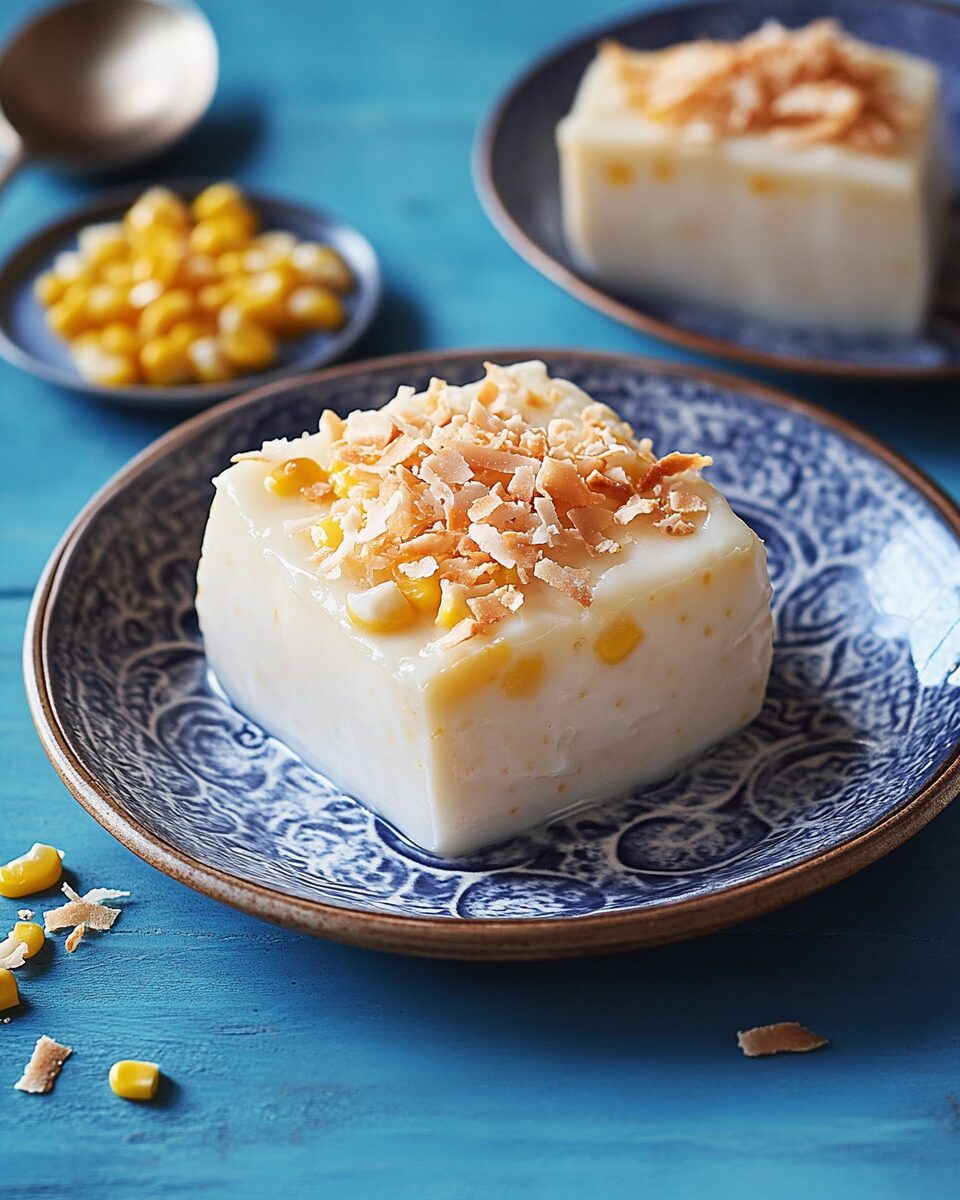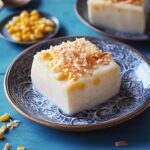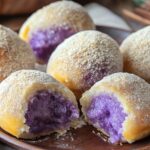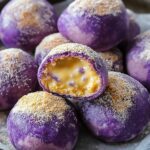Maja Blanca is a popular Filipino dessert made from coconut milk, corn, and cornstarch. It is a smooth, creamy treat that is often enjoyed during special occasions and gatherings.
FULL RECIPE
Ingredients
- 2 cups coconut milk
- 1 cup corn kernels (fresh or canned)
- 1 cup cornstarch
- 1 cup sugar
- 1/2 teaspoon salt
- 1 1/2 cups water
- 1/2 cup toasted grated coconut (for topping)
Directions
- In a saucepan, combine coconut milk, corn kernels, sugar, and salt. Stir and bring to a gentle simmer over medium heat.
- In a separate bowl, mix cornstarch with water to create a smooth slurry.
- Gradually pour the cornstarch slurry into the saucepan, stirring constantly to prevent lumps.
- Continue cooking while stirring until the mixture thickens and becomes a smooth custard-like consistency.
- Once thickened, remove from heat and pour the mixture into a greased dish or mold.
- Let the maja blanca cool to room temperature before refrigerating for at least 2 hours to set.
- Once chilled, top with toasted grated coconut before serving.
Nutritional Information
- Calories: 180 per serving (1/8 of the recipe)
- Protein: 2g
- Carbohydrates: 39g
- Fat: 4g
- Fiber: 2g
- Sugar: 20g
History of Maja Blanca
Maja Blanca is a beloved Filipino dessert that has stood the test of time. Its origins can be traced back to the Spanish colonial era, where it was influenced by Spanish culinary traditions. This dessert represents the fusion of indigenous Filipino ingredients, such as coconut milk and corn, with foreign techniques, resulting in a dish that is both rich in flavor and cultural significance. Over time, Maja Blanca has become a staple in Filipino households, often making an appearance during special celebrations, holidays, and family gatherings.
The Role of Coconut Milk in Filipino Cuisine
Coconut milk is a key ingredient in Filipino cooking, found in both savory and sweet dishes. For Maja Blanca, coconut milk provides the rich, velvety base that makes the dessert so irresistible. The Philippines, being a major producer of coconuts, has embraced coconut milk as a primary ingredient in countless recipes. From hearty stews like ginataang dishes to sweet treats like Maja Blanca, the versatility of coconut milk plays a pivotal role in Filipino food culture, offering both texture and flavor in a wide range of dishes.
The Importance of Corn in Maja Blanca
Corn is another essential component of Maja Blanca, contributing both texture and sweetness. Whether in the form of whole kernels or cream-style, corn adds a mild, natural sweetness that balances out the richness of the coconut milk. This combination creates the perfect harmony of flavors that define Maja Blanca. Corn is also a common ingredient in Filipino desserts, showcasing the adaptability of the Filipino kitchen, where sweet and savory flavors often blend seamlessly.
Texture and Consistency of Maja Blanca
One of the standout features of Maja Blanca is its smooth, custard-like texture. This is achieved through the careful use of cornstarch, which helps to thicken the mixture while keeping the dessert light and creamy. The cornstarch binds the ingredients together, creating a firm yet smooth consistency that holds its shape when sliced. The texture is a critical element of the dish, making it not only visually appealing but also incredibly satisfying to eat.
Variations of Maja Blanca
While the traditional recipe for Maja Blanca is simple, there are numerous variations of the dish that add unique twists to its flavor profile. Some people incorporate additional ingredients such as pandan for fragrance, leche flan for added richness, or jackfruit for an exotic twist. These variations allow for personalization of the dessert, giving cooks the flexibility to cater to different tastes and preferences. In this way, Maja Blanca is a dish that can evolve and adapt, while still maintaining its classic identity.
Maja Blanca as a Holiday Dessert
Maja Blanca is closely associated with Filipino holidays and celebrations. It is often served during Christmas, New Year, birthdays, and other festive occasions. The rich flavor and creamy texture make it a perfect treat for gatherings, where food plays a central role in bringing people together. In the Philippines, the presence of Maja Blanca on the table signifies a celebration of family, togetherness, and the joy of sharing a delicious meal.
The Significance of the Toasted Coconut Topping
The toasted coconut topping on Maja Blanca not only adds a delightful crunch but also enhances the flavor of the dessert. The nutty, slightly caramelized taste of the toasted coconut provides a perfect contrast to the creamy base, creating a balanced and multi-textured dessert. The addition of toasted coconut is a simple yet impactful detail that elevates the overall experience of enjoying Maja Blanca.
Maja Blanca in Filipino Street Food Culture
In addition to being a popular dessert in Filipino homes, Maja Blanca has also become a common sight in Filipino street food markets. Street vendors often serve Maja Blanca in small cups, making it easy for people to grab a quick, refreshing treat while on the go. This portable version of the dessert has contributed to its widespread popularity, as it is both delicious and convenient, especially in the warm tropical climate of the Philippines.
Serving Maja Blanca
Maja Blanca is best served chilled or at room temperature, and it is typically cut into neat squares or rectangular pieces. Its simple presentation makes it an inviting dessert, while its smooth texture and sweet flavor ensure it is a crowd-pleaser. Sometimes, it is topped with extra toasted coconut or even a drizzle of condensed milk for added sweetness. The flexibility in its presentation and serving method makes Maja Blanca suitable for a variety of occasions.
Maja Blanca’s Nutritional Profile
Although Maja Blanca is a rich and indulgent dessert, it also provides some nutritional benefits. Coconut milk, which is a key ingredient, is a good source of healthy fats, specifically medium-chain triglycerides (MCTs), which are easier for the body to process. Corn, another main component of the dish, provides dietary fiber and essential vitamins, such as vitamin C and B-complex vitamins. While it is high in calories and sugar, Maja Blanca can be enjoyed in moderation as part of a balanced diet.
Adapting Maja Blanca for Vegan and Dairy-Free Diets
Maja Blanca is naturally dairy-free, making it an ideal dessert for those following vegan or dairy-free diets. The traditional recipe, which uses coconut milk, is already suitable for these dietary preferences. For those looking to make the dessert even more plant-based, alternatives such as plant-based sugars or other dairy-free options can be used without compromising the dish’s flavor or texture. This makes Maja Blanca an inclusive dessert for a wide range of dietary needs.
Maja Blanca in Modern Filipino Kitchens
In modern Filipino kitchens, Maja Blanca continues to be a beloved dessert. While the classic recipe remains a favorite, many home cooks experiment with different variations of the dish. Some add chocolate for a richer flavor, while others turn Maja Blanca into a frozen dessert or ice cream. The adaptability of Maja Blanca ensures that it remains a relevant and popular treat in Filipino kitchens, even as tastes evolve.
Maja Blanca in Filipino Family Traditions
For many Filipino families, Maja Blanca is more than just a dessert—it is a tradition that brings families together. Passed down through generations, each family adds their own unique touch to the recipe. Whether it’s a secret ingredient or a special technique, these personal touches make the dessert feel more meaningful. The tradition of making and sharing Maja Blanca fosters a sense of connection and continuity within Filipino households.
Why Maja Blanca is Perfect for Potlucks and Gatherings
Maja Blanca is an ideal dessert for potlucks, parties, and large gatherings. Its ability to be prepared in advance makes it convenient for busy hosts, and its large serving size means it can be shared among many guests. The simplicity of the recipe, along with its widespread appeal, makes Maja Blanca a go-to option for feeding a crowd. Whether served in individual cups or cut into squares, it is a dessert that everyone can enjoy.
The Cultural Significance of Maja Blanca in the Philippines
Maja Blanca holds deep cultural significance in the Philippines. Beyond its delicious flavor, the dessert represents the spirit of Filipino hospitality and generosity. Serving Maja Blanca at family gatherings or public festivals is a way to share a piece of Filipino heritage with others. It is a dessert that reflects the values of family, community, and celebration, making it an important part of Filipino culture.
Maja Blanca in Filipino Festivals
Filipino festivals, such as Pahiyas and Sinulog, are vibrant celebrations of culture, food, and tradition. Maja Blanca is often featured as part of the culinary offerings during these festivals, where it is enjoyed by both locals and tourists alike. The dessert not only adds to the festive atmosphere but also serves as a reminder of the Philippines’ rich food heritage. In these settings, Maja Blanca becomes more than just a dish; it becomes a symbol of the joy and unity that festivals bring.
Maja Blanca as a Comfort Food
For many Filipinos, Maja Blanca is a comfort food that evokes fond memories of childhood and family gatherings. The rich, creamy texture and sweet flavor make it a perfect dessert for moments of relaxation and nostalgia. Whether enjoyed after a long day or during a special occasion, Maja Blanca has the ability to comfort and satisfy, offering a sense of warmth and familiarity.
Maja Blanca and its Global Appeal
While Maja Blanca is deeply rooted in Filipino culture, it has also gained recognition beyond the Philippines. As Filipino communities have spread across the globe, they have introduced dishes like Maja Blanca to new audiences. Its creamy texture and tropical flavors make it appealing to people from various cultural backgrounds, contributing to its growing popularity outside the Philippines.
Conclusion
Maja Blanca is more than just a dessert—it’s a symbol of Filipino heritage, culture, and tradition. Its rich history, simple yet flavorful ingredients, and versatile nature make it a beloved dish in Filipino kitchens and beyond. Whether enjoyed during holidays, served at family gatherings, or sold by street vendors, Maja Blanca continues to bring people together. Its enduring popularity speaks to the timeless appeal of Filipino cuisine and the ability of food to connect us to our roots, culture, and family.






